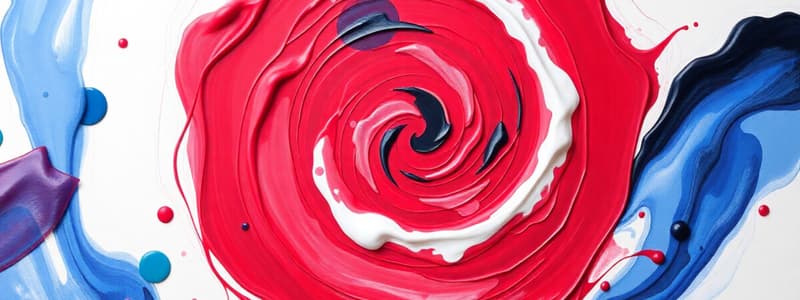Podcast
Questions and Answers
What effect does teachers' intervention in children's artwork typically have on creativity?
What effect does teachers' intervention in children's artwork typically have on creativity?
- It encourages children to take more risks in their creative processes.
- It hinders the development of children’s artistic skills. (correct)
- It allows children to freely experiment with their materials.
- It fosters a sense of independence in children's artistic expression.
What is a major drawback of providing specific instructions for art activities to children?
What is a major drawback of providing specific instructions for art activities to children?
- Children develop unique designs based on the instructions provided.
- It allows children to express their ideas more effectively.
- It leads to a greater understanding of artistic techniques.
- Children become overly dependent on guidance. (correct)
Why might closed-ended art activities negatively impact children's learning?
Why might closed-ended art activities negatively impact children's learning?
- They provide too many options for children to choose from.
- They require advanced artistic skills to execute properly.
- They are better at teaching personal expression than open-ended activities.
- They promote uniformity and discourage personal expression. (correct)
How can teachers' fixation on a perfect product affect children's artistic development?
How can teachers' fixation on a perfect product affect children's artistic development?
What is a potential benefit of tightly controlled art processes mentioned in the content?
What is a potential benefit of tightly controlled art processes mentioned in the content?
What is a primary characteristic of process art?
What is a primary characteristic of process art?
Which of the following activities is an example of product art?
Which of the following activities is an example of product art?
How does process art support cognitive development in children?
How does process art support cognitive development in children?
What is a significant drawback of product-based art activities?
What is a significant drawback of product-based art activities?
In what way do open-ended art activities provide emotional benefits?
In what way do open-ended art activities provide emotional benefits?
Which option describes a process art activity?
Which option describes a process art activity?
What is the main focus of product art in educational settings?
What is the main focus of product art in educational settings?
Which of the following is NOT a benefit of process art?
Which of the following is NOT a benefit of process art?
What critical skill does product art primarily practice in children?
What critical skill does product art primarily practice in children?
How do open-ended art projects differ in time consumption compared to product-based activities?
How do open-ended art projects differ in time consumption compared to product-based activities?
What is a common characteristic of activities classified as product art?
What is a common characteristic of activities classified as product art?
Which of the following reflects a key advantage of process art?
Which of the following reflects a key advantage of process art?
How can process art contribute to a child's social development?
How can process art contribute to a child's social development?
What type of creativity does product art typically emphasize?
What type of creativity does product art typically emphasize?
Flashcards are hidden until you start studying
Study Notes
Open-Ended Art (Process Art)
- Emphasizes exploration and experience over a final product.
- Encourages experimentation and discovery, fostering creativity.
- Child-led activities enable freedom in material choice and usage.
- Supports development of fine motor skills as children manipulate various materials.
- Enhances problem-solving abilities through realization of personal ideas.
- Aids cognitive growth by promoting innovative thinking.
- Offers emotional and social benefits, facilitating expression of feelings and collaboration.
- Example activities include finger painting, collage making, and clay sculpting.
- Focuses on allowing freedom in exploring textures, colors, and forms without end-product pressure.
Product Art (Closed-Ended Art)
- Involves predetermined outcomes and is often teacher-directed.
- Focuses on replicating specific examples or following strict instructions.
- Can limit creativity due to its structured nature; primary goal is the end result.
- Valuable for practicing skills like cutting, gluing, and coloring within lines.
- Example activities include holiday crafts, model assembly, and coloring pre-drawn images.
- Encourages discipline and patience; offers a sense of accomplishment upon completion.
- Often found in classroom settings where consistency and reproducibility are prioritized.
Comparison of Approaches
- Product-based activities often led by instructors, leading to a lack of individual expression.
- Process-based activities promote long-term engagement, creativity, and interaction with materials.
- Teaching techniques in product art can overshadow children's artistic development.
- Reliance on identical outputs in product art emphasizes uniformity over originality.
- Ideal art experiences balance structured instruction with opportunities for personal exploration.
Studying That Suits You
Use AI to generate personalized quizzes and flashcards to suit your learning preferences.




